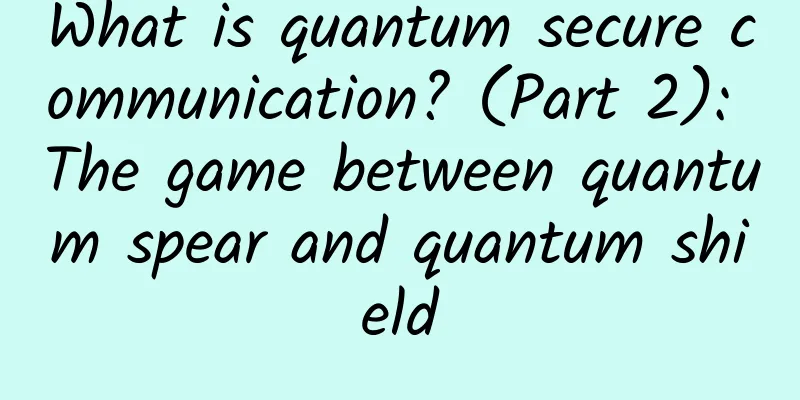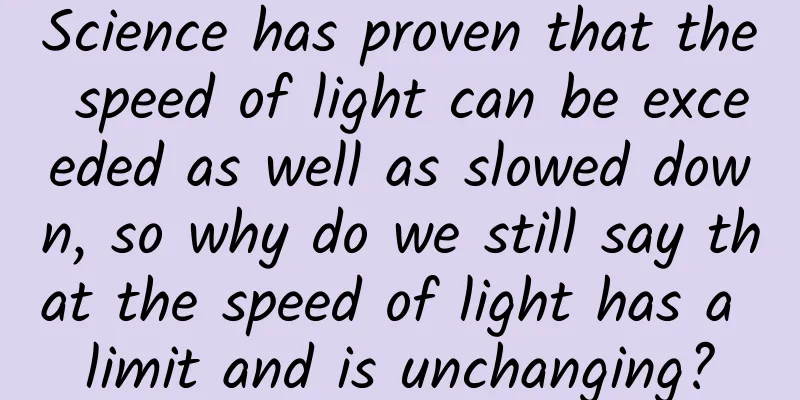What is quantum secure communication? (Part 2): The game between quantum spear and quantum shield

|
Produced by: Science Popularization China Author: Luan Chunyang (Department of Physics, Tsinghua University) Producer: China Science Expo With the continuous development of the information age, the Internet has become one of the most important channels for information transmission in our lives. However, how to protect important information such as confidential files, encrypted data and personal privacy in this vast network world has become a problem that has attracted much attention. The key to solving this problem lies in the popularization and application of confidential communications. In fact, confidential communication is no longer a high-level technology in certain specific fields. It has penetrated into every aspect of our production and life. In the banking system, how can the financial information of each account be transmitted safely? How can the encrypted data be protected within the enterprise? These are all application examples of confidential communication, reflecting the great role of this technology. Protect personal information with accounts and passwords (Photo source: Veer Gallery) In the previous article, we introduced how classical cryptography established codes. In this article, we will continue to introduce how modern confidential communications ensure the security of our information. Asymmetric encryption - I'm telling you I don't believe you can eavesdrop Before talking about "asymmetric encryption", let's first get familiar with the simpler "symmetric encryption". Schematic diagram of "symmetric encryption" method (Image source: Wikipedia) Suppose Xiao Li wants to send an encrypted message to Xiao Wang, but does not want it to be eavesdropped by criminals. Then, Xiao Wang and Xiao Li can prepare a safe in advance and keep two keys to open the safe. In this way, Xiao Li can use the key to put the encrypted information in the safe every time, and Xiao Wang only needs to use the same key to open the safe, and the confidential communication between the two of them can be completed. Here, the information that needs to be encrypted is called "plaintext", the encrypted information is called "ciphertext", and the key used for encryption is called "key". At this time, Xiao Li and Xiao Wang use the same key in the encryption and decryption process, that is, they use the same key, so this encryption method is also called "symmetric encryption". In fact, the wooden sticks used for encryption in ancient Greece and the Caesar cipher for adjusting the order of letters mentioned in the previous article are all symmetric encryption methods. Admittedly, this encryption and decryption process uses the same key, which is very convenient to use, but there is also a great risk of leakage. This is because once the criminals know the encryption key, they can quietly eavesdrop on the encrypted information between Xiao Wang and Xiao Li. In order to make up for the above-mentioned encryption loophole, people invented an "asymmetric encryption" method, that is, the key used by Xiao Li to lock the safe and the key used by Xiao Wang to unlock the safe are no longer the same key. Schematic diagram of "asymmetric encryption" (Image source: drawn by the author) For example, if Xiao Li wants to send an encrypted message to Xiao Wang, Xiao Wang will prepare two different keys, a locking key and an unlocking key. In this case, Xiao Wang will first send the locking key and the safe to Xiao Li, and then Xiao Li will use the locking key to store the message in the safe, and finally Xiao Wang will use the unlocking key he left to open the safe. In this process, only Xiao Wang has the unlocking key, so even if criminals get the safe and the locking key, they cannot read the encrypted information. In this confidential communication process, the key used to lock is also called the "public key", and the key to unlock is called the "private key". This asymmetric encryption method is also one of the mainstream confidential communication methods today. "The Spear of Quantum" - The "disruptive" deciphering of quantum computers It can be said that the above-mentioned "asymmetric encryption" method is very cleverly designed. The communicating parties can safely and boldly make the ciphertext and public key public without worrying about criminals deciphering the encrypted information. Concept diagram based on public key encryption (Photo source: veer photo gallery) The two keys prepared by Xiao Wang, namely the public key and the private key, are always generated by complex mathematical operation rules . Xiao Wang and Xiao Li always update this mathematical operation rule regularly to ensure that criminals cannot calculate the internal relationship between the public key and the private key within a limited time. Therefore, Xiao Wang and Xiao Li are confident that even if criminals get the public key, they can do nothing about the confidential communication between them. However, this encryption is not unbreakable. If the eavesdropper has super computing power, it is possible to calculate the intrinsic relationship between the public key and the private key in a very short time, thereby completely subverting the mainstream encrypted communication method between Xiao Wang and Xiao Li. The emergence of quantum computers is expected to give criminals this super computing power, thereby breaking the "encryption shield" that protects our information. The fundamental reason why quantum computers have potential super computing power is that they perform operations based on the basic principles of quantum mechanics, which is fundamentally different from the computing methods used by traditional classical computers. Concept diagram of quantum computing (Photo source: Veer Gallery) Classical computers use classical bits, which are like the two sides of a coin, either 0 or 1. Quantum computers use quantum bits (qubits), which can be either 0 or 1, or can be in a superposition of 0 and 1 at the same time, just like having both sides of a coin at the same time. This feature allows quantum computers to process multiple possibilities in parallel at an astonishing speed in some cases, without having to queue up one by one, thus greatly speeding up the computing process. Therefore, with the emergence of practical quantum computers in the future, the criminal Xiao Wang will make it impossible for Xiao Wang and Xiao Li to guarantee the absolute security of the above-mentioned "asymmetric encryption" method. Therefore, in order to resist the computing power attack of the "quantum spear", we have to start changing our thinking and start looking for more effective encryption methods to ensure communication security. "Quantum Shield": I don't believe you can still eavesdrop! In fact, no matter how complex and varied the encryption method is, there are always two loopholes that need to be filled in order to ensure its absolute security. Network Security Firewall (Photo source: Veer Gallery) First, once the eavesdropper has super computing power, he can decipher the keys of both parties in a very short time; second, neither Wang nor Li can know whether the eavesdropper has stolen the encrypted information. Relatively speaking, the second flaw mentioned above is often more fatal, because the eavesdropper will pretend that he has not deciphered the encrypted information and steal the communication between the two parties for a long time without any sound. Fortunately, quantum mechanics is not biased towards the "quantum spear" that can decipher keys. Scientists have also designed a more powerful "quantum shield" based on the basic principles of quantum mechanics to protect the absolute security of encrypted information. The first loophole is relatively easy to fix. If Xiao Wang and Xiao Li randomly change the key every time they communicate, then even if the eavesdropper has super computing power, he can only decipher the confidential information once. This method of changing the encryption key every time the two parties send information is called "one-time one-pad". To make up for the second loophole, we need to use a special property in quantum mechanics, namely quantum entanglement. In order to understand quantum entanglement more vividly, we can give an interesting example. Suppose a pair of twin sisters study in Beijing and Shanghai respectively, and a classmate in Beijing asks one of the twins, "Are you the older sister or the younger sister?" Then the classmate can instantly infer the situation of the other twin in Shanghai based on her answer. This is because before being asked about the sisterhood of the two twins, in the eyes of the outside world, they are always in a "tangle of being an older sister or a younger sister", and their respective statuses will be determined at the moment of answering. Similarly, if we can prepare a pair of identical quantum bits, they will be in an entangled state of 0 and 1 before being measured. No matter how far apart they are, as long as the state of one of the quantum bits changes, the other related quantum bit will also change accordingly instantly. This phenomenon is called "quantum entanglement." Therefore, Wang and Li can communicate with each other confidentially by sending and receiving a series of quantum bits as the key to encrypt information. In addition, if an eavesdropper starts to steal the key, the quantum entanglement state between Wang and Li will change due to interference. Schematic diagram of quantum key distribution scheme (Image source: drawn by the author) That is to say, if Xiao Wang and Xiao Li find that their quantum entangled states are not disturbed, they can be sure that the communication has not been eavesdropped, that is, it is safe. Therefore, Xiao Wang and Xiao Li can use these quantum entangled states to generate a shared encryption key for encrypting and decrypting their communication content. This method of using the basic principles of quantum mechanics for confidential communication is also called quantum key distribution (QKD). Conclusion It can be said that the quantum key distribution scheme not only has the characteristic of "one-time one key", but also makes full use of the wonderful properties of "quantum entangled state" to monitor whether confidential communications are being eavesdropped. In 1984, the quantum key distribution scheme attracted widespread attention from scientists as soon as it was proposed. The quantum key distribution scheme provides a new way to ensure the security of communications and can serve as a "quantum shield" to protect the absolute security of our communications. Quantum key concept diagram (Photo source: Veer Gallery) After nearly 40 years of development, quantum secure communication technology is also maturing and is gradually entering our real life. I believe you must be still wanting more after reading this. Then, let us tell you the wonderful stories of "going up to the sky" and "going down to the earth" in quantum secure communication! References: [1] Haitjema, M. . A survey of the prominent quantum key distribution protocols. cse.wustl.edu. [2]Buttler WT, Hughes RJ, Kwiat PG, et al. Free-space quantum-key distribution[J]. Physical Review A, 1998, 57(4): 2379. |
<<: “Health from eating” series | How to adjust your diet scientifically after the holidays?
>>: Even enzymes have "customized" versions? Analysis of corn starch deep processing
Recommend
How was the Snake Battle that dominated the charts for over a week and went viral on WeChat Moments created?
The second hit product of 2016, Snake Wars, is he...
These diseases are all related to obesity! If your weight exceeds this number, you are in danger!
How many obese people are there in China? After 1...
It’s not hard labor! Baidu map collectors appear on CCTV again to share the secret weapon of data production
Baidu Maps data collectors are on TV again! After...
Deeply devoted to the grass, with a rolling green shade of love (Part 2) - The "king of ferns" that lived in the same era as the dinosaurs, a review of the "living fossils" in the plant world
Produced by: Science Popularization China Author:...
Increase followers, promotion, IP building, and Weibo operation skills!
Weibo is a social networking platform with great ...
Are the willow catkins that cause you allergies really useless?
There is static electricity in winter and heat in...
How to do free (low cost) promotion online (Part 2)
The previous article "How to do free (low-co...
Engineer sentenced for reporting environmental problems in hometown (attached with original text)
Engineer responds to being sentenced for reportin...
Electric Technology Car News: As a once leading model but now in decline, Tiguan L can still crush its rivals with its performance and space
Tiguan, once the leading model of joint venture S...
How to continuously obtain seed users?
There are many techniques for acquiring seed user...
Detailed explanation of four loading methods of Android
[[125130]] In multi-Activity development, there m...
Japan's "Xiang Xiang" and the United States' "Ya Ya" return to China! How difficult is the road to protecting giant pandas?
There were numerous banners, fans were crying wit...
You read that right, electrodes can be implanted in the brain!
Produced by: Science Popularization China Author:...
The secret of how Douyin influencers sold goods worth 130 million in 6 months!
Why are short videos so popular? What is the real...
China Passenger Car Association: Tesla ranked first in new energy vehicle sales in May, and new forces such as NIO have become important forces in the new energy vehicle market
1. Review of the national passenger car market in...









